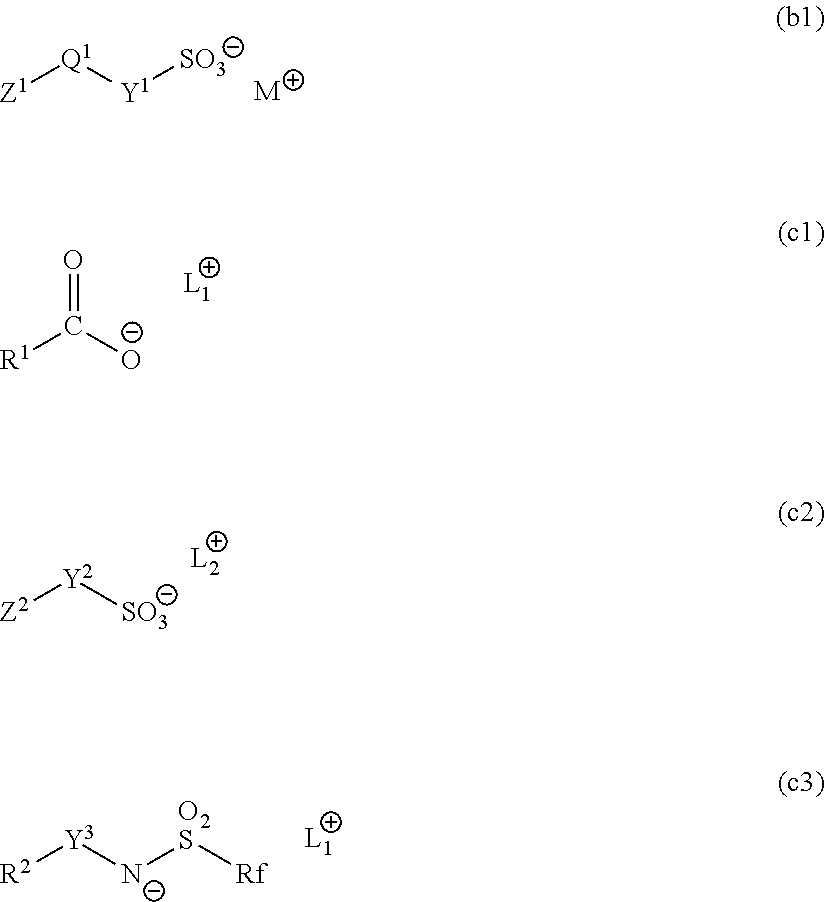Resist composition and method of forming resist pattern
a composition and resist technology, applied in the field of resist composition and resist pattern formation, can solve the problems of deteriorating lithography properties and pattern shape, and significant problems, and achieve the effect of excellent lithography properties
- Summary
- Abstract
- Description
- Claims
- Application Information
AI Technical Summary
Benefits of technology
Problems solved by technology
Method used
Image
Examples
synthesis example 1
Synthesis of N-[2-(adamantan-1-ylcarbonyloxy)ethyl]trifluoromethanesulfonamide
[0665]100 g (0.52 mol) of trifluoromethanesulfonamide ethanol, 108.6 g (0.54 mol) of 1-adamantanecarboxylic acid, 0.1 mol of para-toluenesulfonic acid and 500 g of toluene were added to a glass flask equipped with a thermometer and a condenser, followed by dehydration under reflux using a dean-stark dehydration apparatus. After 9 hours of reflux, about 9 ml of water was removed. The resulting reaction solution was dissolved in 500 g of ethyl acetate, and washing was conducted twice with a saturated sodium hydrogencarbonate solution, once with a 1N—HCl and once with a saturated saline solution in this order. Then, the organic phase was dried with sodium sulfate, and the solvent was distilled off under reduced pressure. The resultant was subjected to recrystallization in hexane, thereby obtaining 140 g of N-[2-(adamantan-1-ylcarbonyloxy)ethyl]trifluoromethanesulfonamide (yield: 75%, purity: 99%).
Properties o...
synthesis example 2
Synthesis of triphenylsulfonium N-[2-(adamantan-1-ylcarbonyloxy)ethyl]trifluoromethanesulfoneamide 240 g (0.63 mol) of
[0669]N-[2-(adamantan-1-ylcarbonyloxy)ethyl]trifluoromethanesulfonamide obtained in Synthesis Example 1 above, 800 ml of water and 800 ml of chloroform were added to a 3L-reactor, and 240 g (0.68 mol) of a 11% NaOH solution was gradually added thereto in a dropwise manner while maintaining the internal temperature of the reactor at 0° C., followed by stirring for 30 minutes. Then, 244 g (0.71 mol) of triphenylsulfonium bromide was added thereto, followed by stirring at room temperature for 15 hours. The resultant was subjected to liquid separation, and the obtained organic phase was washed with 800 ml of water four times, followed by concentration under reduced pressure. The resulting yellow oily substance was dissolved in acetonitrile, and recrystallization was performed in diisopropyl ether (IPE), thereby obtaining 360 g of triphenylsulfonium N-[2-(adamantan-1-ylca...
examples 1 to 18
, Comparative Examples 1 to 12
[0673]The components shown in Tables 1 and 2 were mixed together and dissolved to obtain negative resist compositions.
TABLE 1ComponentComponentComponentComponentComponent(A)Component (B)(C)(E)(F)(S)Ex. 1(A)-1(B)-1(C)-1(E)-1(F)-1(S)-1[100][5.0][3.50][0.10][3.0][2580]Ex. 2(A)-1(B)-2(C)-1(E)-1(F)-1(S)-1[100][6.8][4.20][0.10][3.0][2580]Ex. 3(A)-1(B)-3(C)-1(E)-1(F)-1(S)-1[100][6.5][3.50][0.10][3.0][2580]Ex. 4(A)-1(B)-3(B2)-1 (C)-1(E)-1(F)-1(S)-1[100][4.5][3.0][3.50][0.10][3.0][2580]Ex. 5(A)-2(B)-3(C)-1(E)-1(F)-1(S)-1[100][6.5][4.60][0.10][3.0][2580]Ex. 6(A)-2(B)-3(B2)-1 (C)-1(E)-1(F)-1(S)-1[100][5.0][2.3][3.90][0.10][3.0][2580]Ex. 7(A)-2(B)-3(B)-5(C)-1(E)-1(F)-1(S)-1[100][5.5][4.0][4.60][0.10][3.0][2580]Ex. 8(A)-2(B)-4(C)-1(E)-1(F)-1(S)-1[100][9.5][3.50][0.10][3.0][2580]Ex. 9(A)-2(B)-4(B)-5(C)-1(E)-1(F)-1(S)-1[100][7.5][4.0][3.50][0.10][3.0][2580]Ex. 10(A)-2(B)-5(C)-1(E)-1(F)-1(S)-1[100][16.0] [3.50][0.10][3.0][2580]Ex. 11(A)-3(B)-3(C)-1(E)-1(F)-1(S)-1[100][...
PUM
 Login to View More
Login to View More Abstract
Description
Claims
Application Information
 Login to View More
Login to View More - R&D
- Intellectual Property
- Life Sciences
- Materials
- Tech Scout
- Unparalleled Data Quality
- Higher Quality Content
- 60% Fewer Hallucinations
Browse by: Latest US Patents, China's latest patents, Technical Efficacy Thesaurus, Application Domain, Technology Topic, Popular Technical Reports.
© 2025 PatSnap. All rights reserved.Legal|Privacy policy|Modern Slavery Act Transparency Statement|Sitemap|About US| Contact US: help@patsnap.com



